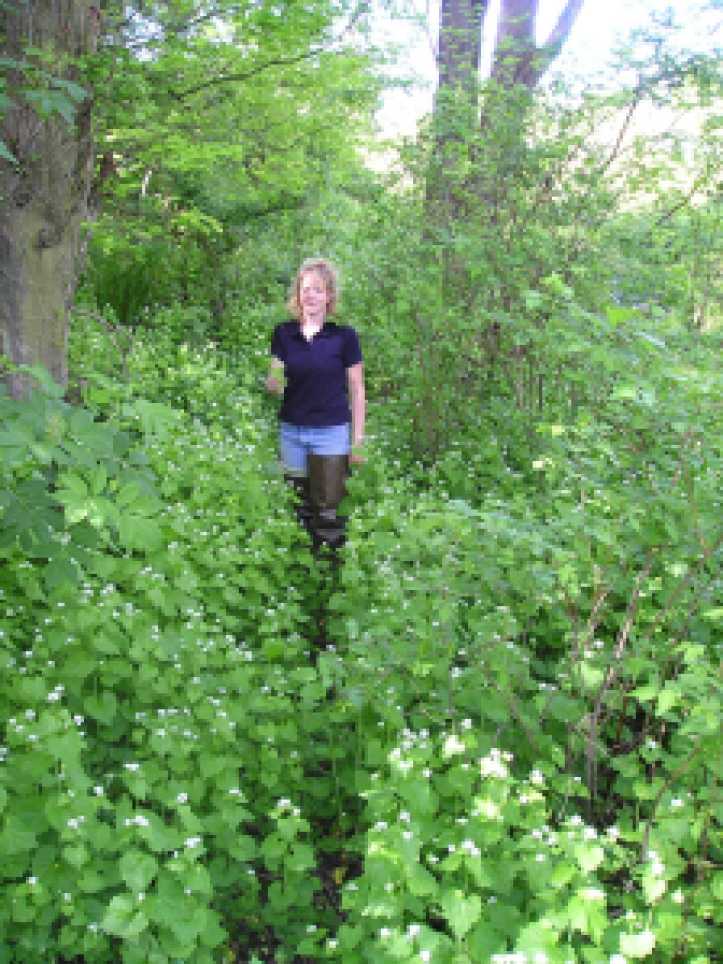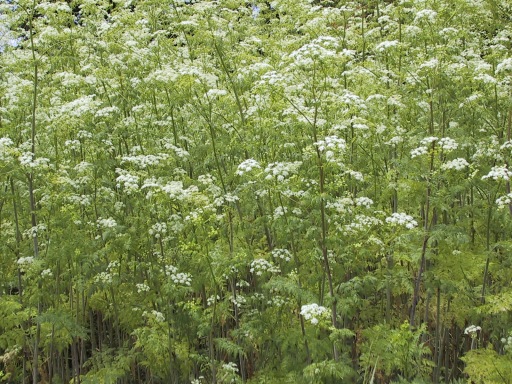If you missed Part 1 you can check it out here.
We often get the question, “so if dandelions and hairy bittercress aren’t noxious weeds – what is?” Noxious weeds aren’t just a nuisance in yards and gardens. These are plants that have significant negative impacts to our natural environment, our economy or to public health. Noxious weeds aren’t evil plants that we’re trying to wipe off the face of the Earth. Somewhere else in the world these plants are a valuable part of a native ecosystem. However, these are plants with overdeveloped survival abilities that allow them to thrive in the mild climate of the Pacific Northwest. And since they are in a new environment without the herbivores, insects and diseases that would normally keep them in check, they have the potential to grow out of control.

Garlic mustard (Alliaria petiolata) is a great example of one of these noxious weeds. You may see a similarity, especially in the four-petaled white flowers and skinny, upright seed pods, to hairy bittercress. That’s because these plants are in fact in the same family. And garlic mustard is also an edible plant, which is how it got here in the first place. Unfortunately, unlike bittercress, garlic mustard is extremely difficult to control. Whereas bittercress is only found in disturbed environments like lawns, gardens and roadsides, garlic mustard can spread into mature forests.

At only 3 feet tall with scalloped triangular leaves, a single garlic mustard plant is pretty unassuming. This camouflaging ability means that garlic mustard infestations often go unnoticed until there are many plants in an area – making it much more difficult and costly to control. Garlic mustard is self-fertile; a single plant can seed generations of plants that completely take over a site in a couple of years. As if that weren’t enough, garlic mustard is allelopathic which means that it produces a chemical that prevents other plants from growing.

Garlic mustard also closely resembles some other common plants both (non-noxious) weeds and native plants. One of these is probably my favorite weed of all: Honesty or silver dollar plant, as I called it as a kid (Lunaria annua).

This is yet another member of the Brassica family and is technically edible but is not the most tasty (although you can make a mustard substitute from the seeds). Lunaria usually has colorful magenta to light purple flowers. These flowers are followed by the distinctive flat oval seed pods that turn shiny, translucent and cream colored as they dry out.

But sometimes Lunaria flowers are white and they have four petals just like garlic mustard. So how are you supposed to tell them apart before you can see the seed pods? The best way to tell garlic mustard apart from its lookalikes involves looking very closely at the leaves and rubbing them between your fingers. Garlic mustard leaves are smooth and mostly hairless (and young leaves will smell like garlic when crushed). But Lunaria leaves, and the other lookalikes, have hairy leaves that will feel fuzzy.

Lunaria is another one of those weeds we’re not that worried about. Introduced species? Yep. Escaped from garden beds and spread through self-seeding? Yep. Causing harm to our natural environment, economy or public health? Nope, or at least not really. Lunaria pops up and can be invasive in disturbed environments (places highly impacted by people) like roadsides, back yards and urban parks. It’s quite a polite plant really: easy to control and does not take over forests (ahem, take a hint garlic mustard!).
One more noxious weed that starts appearing this time of year that is absolutely NOT edible is poison hemlock. This may be a good time to point out that just because a plant is in the same family as edible plants and looks similar does not mean you can eat it. Poison hemlock (Conium maculatum) is in the Apiaceae family along with carrots, celery, parsley, cilantro and other plants that are common in the produce section of any supermarket.

The leaves of poison hemlock look quite similar to these other plants and it has a fleshy taproot that looks like a white carrot. However, mistaking poison hemlock for an edible plant can have dangerous and even deadly consequences. Every part of the poison hemlock plant is toxic when eaten by people, pets or livestock.

The toxic compounds in the sap can even aerosolize (which means that tiny particles get suspended in the air) which can get breathed in and make people sick. That’s why we don’t recommend weed-whacking, mowing, or burning this plant. Not only is poison hemlock a serious health hazard, but it is also invasive. It quickly spreads by seeds in sunny, moist sites and through contaminated soil, compost or mulch.

Listing poison hemlock as a noxious weed may seem obvious but with other plants it’s not always so clear cut. So how are you supposed to tell whether a plant is beneficial, weedy, or noxious? As it turns out, there’s a whole Program for that! The King County Noxious Weed Control Program is dedicated to protecting our shared resources from the negative impacts of noxious weeds. We welcome your emails and phone calls and photos of mystery plants that you’re trying to identify.
The world of weeds is not as black and white as our official noxious weed list might lead you to believe. Often times the categorization of plants mostly comes down to personal preference. It’s important to note that plants aren’t inherently good or bad depending on their country of origin. In a time where we have seen abhorrent acts of racial violence against Asians and Asian Americans in this country and when hate crimes in the Seattle area have increased 63% in the past year, it is past time to stop with the rhetoric that demonizes “exotic” plants. Language always matters and even the way we talk about plants can make our work either divisive or inclusive.
For this reason, we have begun changing the way we describe weeds. Our program is in the process of changing the common names of weeds that reference a nation or region. This effort is just one small step toward reexamining the way we talk about invasive species. We welcome continued discussions on this topic and will be working on ways to make sure all residents of King County feel like they belong in conversations about ecological restoration. What are some of your favorite weeds?
